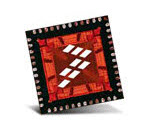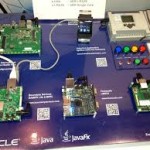The exponential increase of chipsets aimed at the Internet-of-Things market has offers a huge variety of new IP-based products to choose from, which may cause the appearance that older standards such as ZigBee are waning in popularity. However, nothing could be further from the truth, and one example is the new Kinetis KW2x microcontroller family from Freescale Semiconductor.
The Kinetis KW2x is a series of wireless system-on-chip devices aimed at meeting the increased processing and memory requirements associated with applications that use advanced 802.15.4/ZigBee stacks and communications standards in modern Internet-of-Things applications, such as ZigBee Smart Energy 2.0 and the ZigBee Internet Protocol specification, today and into the future.
These devices integrate a 50 MHz ARM Cortex-M4 processor with an 802.15.4-compliant 2.4 GHz RF transceiver on a single chip, providing a low-power, compact, single-chip integrated solution for 802.15.4/ZigBee wireless mesh network applications in home automation, healthcare, smart energy and consumer electronics.
The KW2x family expands on the successful Kinetis microcontroller portfolio based on the ARM Cortex-M4 core, with the software protocol stacks, development tools and IDE all compatible with the existing family of Kinetis MCUs and the ZigBee protocol seamlessly integrated into Kinetis software development tools – allowing you to rapidly get started programming and creating wireless mesh networks for your embedded and IoT applications.
Specifications are rich, as the Kinetis KW2x family integrates a class-leading 2.4 GHz RF transceiver, a Cortex-M4 core and a robust feature set for a powerful, secure and low-power IEEE 802.15.4 wireless solution all integrated on a single die.
These wireless MCUs offer up to 512 KB of flash, 64 KB of RAM and up to 64 KB of FlexMemory. Dual PAN support allows this platform to simultaneously participate in two ZigBee networks, making it useful in complex ZigBee installations or in router or gateway applications.
The KW2x family supports the ZigBee IP network stack, the RF4CE standard, and the ZigBee Home Automation, ZigBee Smart Energy 1.x and ZigBee Smart Energy 2.0 ZigBee application profiles, enabling a broad range of applications.
Along with reducing product size and reducing bill-of-materials cost with a highly integrated solution – the KW2x product line offers strong power efficiency and long battery life in portable, battery-powered Internet of Things applications.
According to Freescale, this family of devices provides greater processing performance and larger flash and RAM options compared to other similar devices on the market, helping smart IoT appliances and consumer automation products avoid obsolescence as 802.15.4/ZigBee specifications evolve, with the ability to meet future standards and new ZigBee application profiles via firmware updates on the same hardware.
The Kinetis KW2x wireless MCU family provides plenty of Flash and RAM, allowing engineers to quickly upgrade products with new features, including over-the-air remote firmware updates, without the need for costly and relatively difficult replacements of the hardware in users’ homes and other installations.
For applications that require more flexibility, the KW2x platform optionally provides 64 kB of “FlexMemory”, that allows users to configure part of the on-chip flash memory as additional flash memory or enhanced EEPROM. This means users can choose how that memory is allocated between program and data storage, for example if extra EEPROM space is desired for storing configuration data.
The KW2x family offers reduced power consumption and an increased RF link budget, along with antenna diversity which improves reliability of the radio link, particularly in environments where multi-path interference is a problem.
The IEEE 802.15.4 2.4GHz transceiver is designed to reduce transmission power where appropriate, and run in a low-power mode when commanded, helping to achieve strong power efficiency. These devices include hardware assisted dual personal area network support, which means that a single device can communicate wirelessly on two different ZigBee networks, simultaneously using two different PAN IDs.
This makes these chipsets attractive for gateway or router applications in home or building automation networks, connecting together different smart energy or home automation networks without the need for multiple radios.

Security has not been forgotten – as Freescale have integrated advanced security features usually found in higher-end processors, providing security and cryptographic functions including key generation, secure memory and tamper detect functionality.
Secure Flash protects the code and data from unauthorised access or modification, while tamper detection can identify events and asynchronously erase secure RAM, generating an interrupt so the application firmware can take additional actions, including a system reset.
A dedicated cryptographic acceleration unit supports a set of specialised operations to improve the throughput of encryption and decryption operations as well as message digest functions. These features address the growing attention and the need for strong security in embedded SCADA and automation systems as well as connected Internet-of-Things consumer products in the home.
As leaders in Zigbee-based product development, we’re ready to work together with you to develop new product designs, or reviewing and upgrade any existing versions with you for your success. Getting started is easy – click here to contact us, or telephone 1800 810 124.
LX is an award-winning electronics design company based in Sydney, Australia. LX services include full turnkey design, electronics, hardware, software and firmware design. LX specialises in embedded systems and wireless technologies design.
Published by LX Pty Ltd for itself and the LX Group of companies, including LX Design House, LX Solutions and LX Consulting, LX Innovations.


